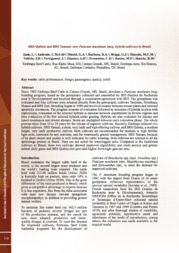BRS Quênia and BRS Tamani: new Panicum maximum Jacq. hybrid cultivars in Brazil.
BRS Quênia and BRS Tamani: new Panicum maximum Jacq. hybrid cultivars in Brazil.
Author(s): JANK, L.; ANDRADE, C. M. S. de; MACIEL, G. A.; BARBOSA, R. A.; BRAGA, G. J.; MACEDO, M. C. M.; VALÉRIO, J. R.; VERZIGNASSI, J. R.; ZIMMER, A. H.; FERNANDES, C. D.; SANTOS, M. F.; SIMEÃO, R. M.
Publication year: 2021
Types of publication: Paper in annals and proceedings
Unit: Embrapa Beef Cattle
Observation
Some of Embrapa's publications are published as ePub files. To read them, use or download one of the following free software options to your computer or mobile device. Android: Google Play Books; IOS: iBooks; Windows and Linux: Calibre.
Access other publications
Access the Agricultural Research Database (BDPA) to consult Embrapa's full library collection and records.
Visit Embrapa Bookstore to purchase books and other publications sold by Embrapa.

